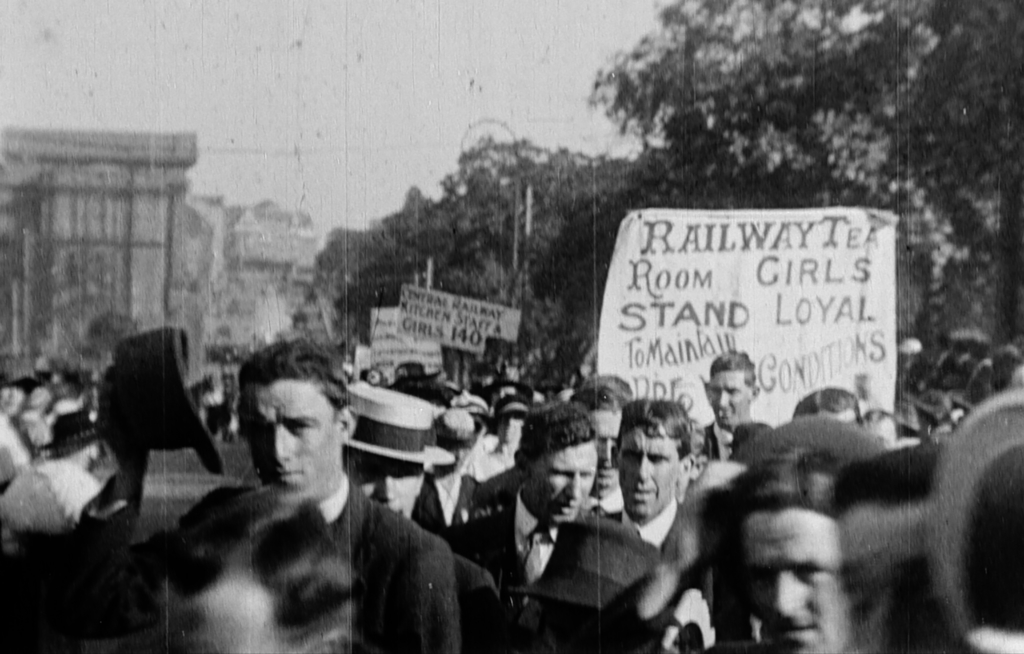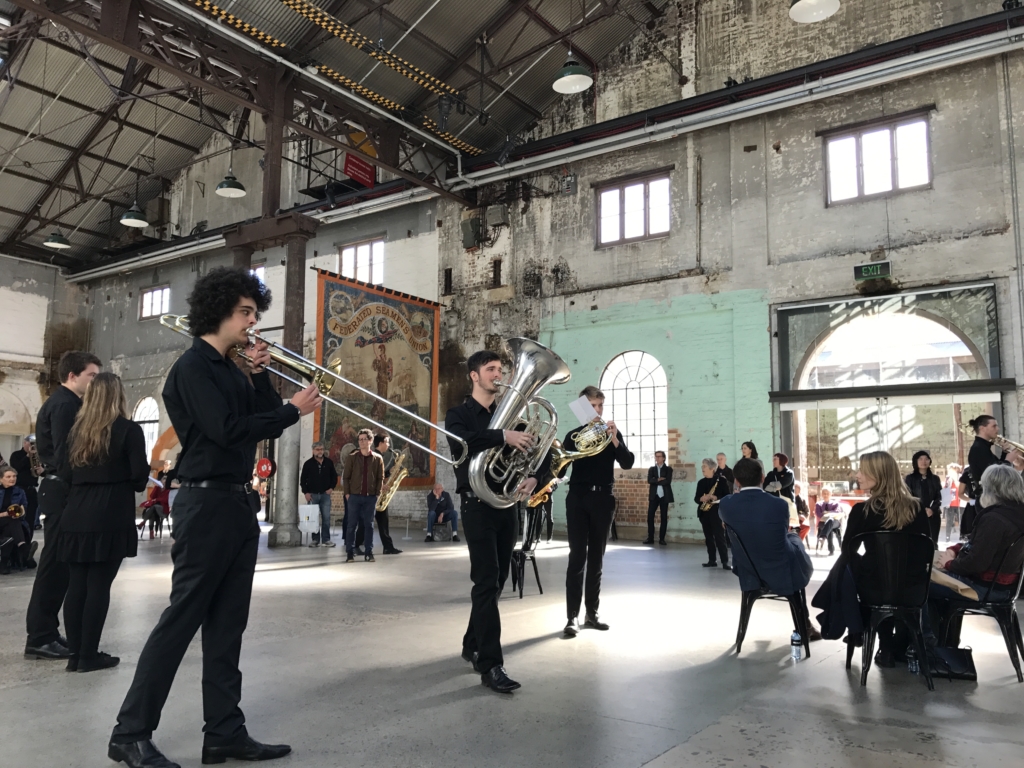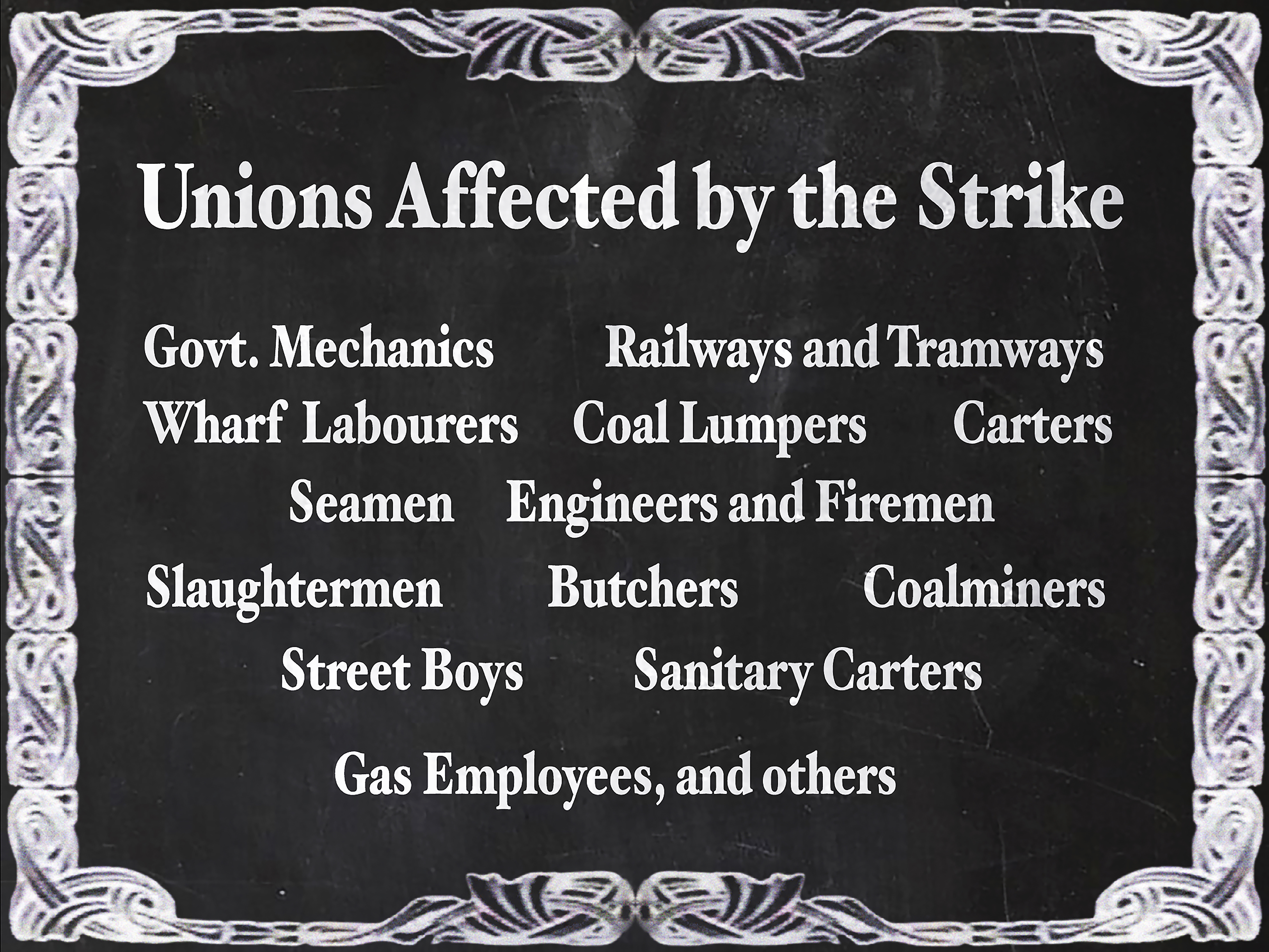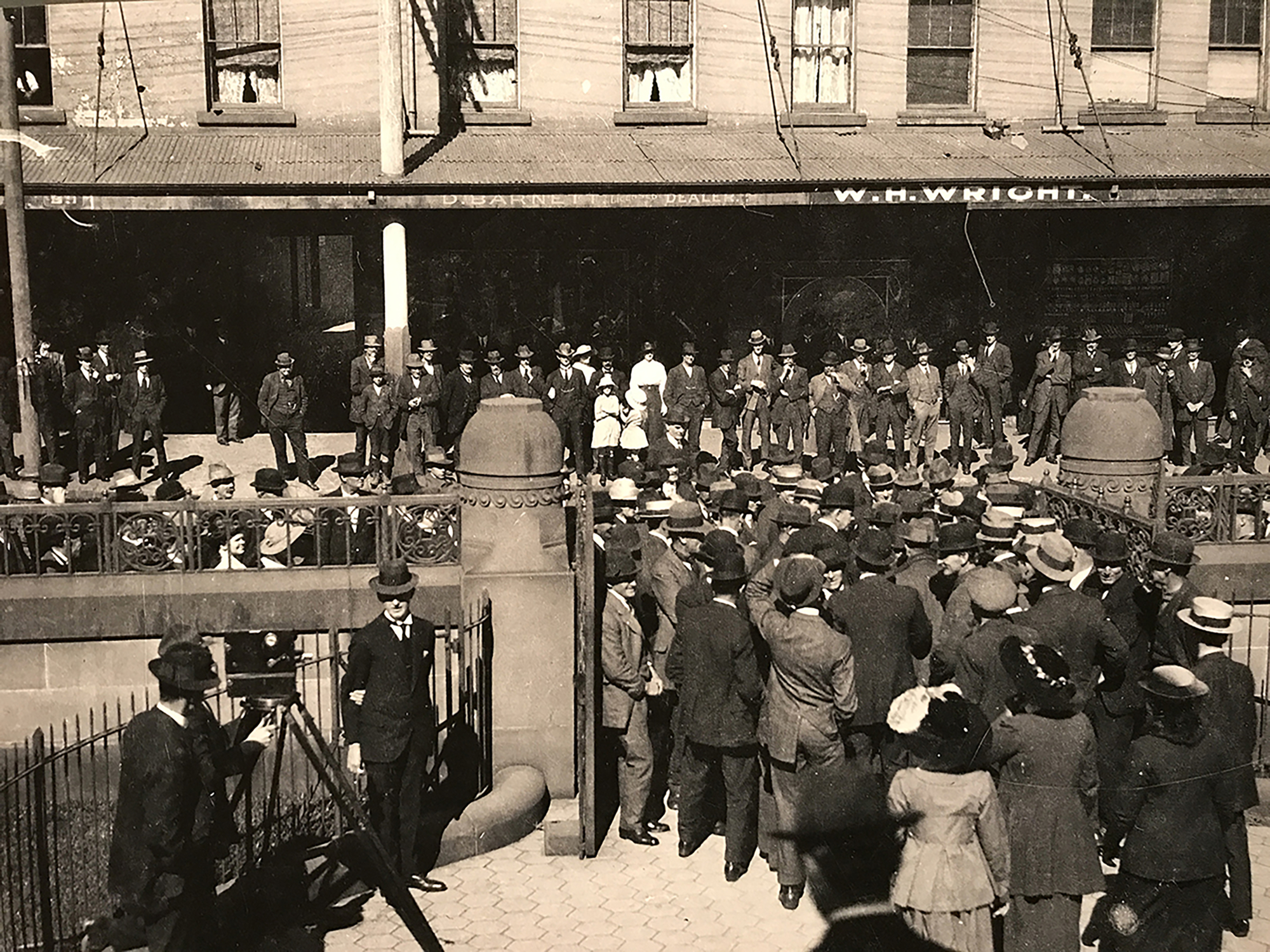The written history of Australia since invasion is, as is well known, riddled with holes, omissions and inaccuracies. One such gap, undoubtedly, is the nation’s long tradition of industrial action and unionism. Anyone looking to read up on the subject is faced with precious few literary options, Tom Bramble’s well-regarded 2008 book Trade Unionism in Australia: A History from Flood to Ebb Tide notwithstanding. Perhaps there is a need for a comprehensive tome on the topic for general readers. In film, the pickings have been slimmer still – even close to non-existent. Amanda King’s The Great Strike 1917 (2019) is, therefore, a welcome and important addition to our continuing national dialogue regarding workers’ rights, unions, class and power.
This documentary is wholly devoted to the titular historical incident, also known as ‘the New South Wales General Strike’.[1]See Lucy Taksa, ‘The 1917 General Strike’, Evatt Journal, vol. 16, no. 5, December 2017, available at <https://evatt.org.au/papers/1917-general-strike.html>, accessed 4 May 2020. While this was a traumatic event for the country, it is one that, as the film explains, appears to have been somewhat lost in the annals of history. In this elegant and insightful exercise in non-fiction storytelling, King mixes straightforward social context, narrative and analysis from academics and experts with a fascinating behind-the-scenes look at an exhibition held at Sydney’s Carriageworks arts centre in 2017 to mark the hundredth anniversary of the strike. This involved several prominent Australian artists, who commemorated the strike in a variety of enigmatic and imaginative ways. The film also devotes a significant amount of time to arguably the strike’s most tragic and disturbing episode, the murder of a striker by a strikebreaker.
As the film is at pains to point out, the strike must be understood in the context of the public mood at the time. The year 1917 was, after all, the worst year of World War I in terms of Australian casualties,[2]Joan Beaumont, ‘Australia’, 1914-1918-online. International Encyclopedia of the First World War, updated 18 March 2015, <https://encyclopedia.1914-1918-online.net/article/australia>, accessed 20 April 2020. and, according to historian Val Noone in King’s film, ‘the most bitter year in white Australian history’. With national morale teetering on the brink and the very real possibility of conscription looming,[3]ibid. income levels and quality of life among industrial workers was suffering.
In order to track workers’ output in these tumultuous years, the New South Wales Government Railways and Tramways department in Sydney introduced a ‘card system’ for Eveleigh Rail Yards (now Carriageworks) and Randwick Tram Sheds, which would record time and productivity. This workplace monitoring had its roots in American management methods, and was part of a wider ‘national efficiency’ campaign. A new classification of employee, the sub-foreman, would be watching over workers as they went about their duties.[4]Taksa, ‘The 1917 General Strike’, op. cit.
For the strikers, this dehumanised them, infantilised them and destroyed camaraderie. On 2 August 1917, workers at the aforementioned sites abandoned their posts, setting in motion a strike that would spread across various industries (such as mining, shipping, sugar and many more) and to other states and cities. The strike would end in early September for the New South Wales rail and tram workers, and continue until late October for workers in other sectors.[5]ibid. A total of fourteen unions[6]Andrew Moore & Lucy Taksa, ‘Merv Flanagan: The Australian Labour Movement’s Forgotten Martyr’, The Hummer, vol. 1, no. 21, 1988, available at <https://asslh.org.au/hummer/no-21/martyr/>, accessed 4 May 2020. were initially involved, increasing to more than twenty.[7]Taksa, ‘The 1917 General Strike’, op. cit. A figure approaching 100,000 strikers is commonly quoted.[8]ibid.

The first quarter of King’s film is devoted to the build-up to the strike, addressing unions, the war effort’s impact on industry and the spiralling cost of living. The key contributors in this important scene-setting are New South Wales MLC John Graham, historian Lucy Taksa and journalist Frances Morgan, all of whom expand on the antagonistic divide that emerged between strikers and management, which became increasingly incendiary as the strike progressed and the various protest marches through Sydney drew more and more people.
After this thorough introduction to the strike itself, The Great Strike 2017 turns its attention to the Carriageworks exhibition, and it is here that the film truly gets into its stride, teasing out deeper, more diverse and more nuanced interpretations of this historical incident. None of the participating artists had any prior knowledge of the strike – a symptom of its absence from our national consciousness. And amid all the studious experts and historians featured in the documentary, it is actually these artists who deliver the most interesting comments and reflections on the strike’s injustices and consequences. King relies on the artists to inject a sense of humanity and passion into the film, following the comparatively dry history lesson that has come beforehand.
The artist Sarah Contos, for example, creates patchwork quilts to acknowledge the contribution of women to the protest marches. Will French reimagines the old-style train-schedule boards, with their wooden rotating slats, to celebrate the craftsmanship of workers amid the new conditions that promised to turn them into automatons. Raquel Ormella uses secondhand, discarded work clothes to create banners that display the names of famous strikers, and to tap into a sensory experience of working in railway yards through touch and smell. And perhaps most fascinatingly, Tom Nicholson and Andrew Byrne create an experimental sound piece with a brass band, drawing from photographs of strike gatherings and the protest songs of the time, such as ‘Solidarity Forever’.

The film returns to its historians and academics to chart the course of the strike across the late winter and early spring of 1917, including the government’s move to enlist ‘volunteers’, or strikebreakers, from regional areas to travel to Sydney and perform the work of the absent strikers (from the volunteers’ perspective, they were helping the war effort). It is this development in the strike that leads the film to its narrative heart: the murder of striker Merv Flanagan by volunteer Reginald Wearne.
Wearne, a stockman and station agent, hailed from Bingara in the New England region of New South Wales. His brother, Walter, was a conservative politician and, as an Independent Nationalist, the state member for Namoi. Wearne had been recruited as a regional volunteer, and was among other ‘scabs’, as these strikebreakers were known, who would be jeered and mocked by strikers as they made their way through the city on carts. During one such journey through Camperdown, an altercation with Flanagan resulted in Wearne pulling a revolver on the striker and killing him in front of his brother James and another picketer, Henry Williams. What followed was an egregious distortion of justice as Wearne, through his brother, was able to draw on powerful connections, along with plenty of legal-system bias, to be acquitted of any crime. James Flanagan, meanwhile, was convicted of ‘using violence with intent to prevent Wearne from following his lawful occupation’.[9]See Laila Ellmoos, ‘Great Strike of 1917’, Dictionary of Sydney, 2018, <https://dictionaryofsydney.org/entry/great_strike_of_1917>, accessed 4 May 2020.
King combines Tinsdale’s film with archival photographs, and these older materials make for an enthralling contrast with the works of the artists, in all their vivid colours.
This section of The Great Strike 1917 is driven by the descriptive powers of Morgan, who in 2017 released a rigorously researched podcast, The Folded Lie, that told the story of the Flanagan murder in expansive detail. Throughout the retelling of this sad tale in the film, Morgan ensures that legal injustice and class discrimination are never far from the viewer’s mind, and that, again, a moving sense of the human cost of the strike is woven into the more political and administrative details of industrial relations and unionism. The emotion is further heightened towards the film’s end when Flanagan’s granddaughter, Sandra Williams, is seen tearfully visiting his grave at Rookwood Cemetery in the present day. It is worth noting that, in her excellent podcast, Morgan also visited Bingara to speak with Wearne’s grandson John; including something like this in the film may have provided an intriguing balance, but one can understand King’s decision to keep the emphasis wholly on Flanagan and his family as victims of this institutional wrong.
King is adept at balancing historical scholarship with a focus on the toll the strike took on communities and families. She also dwells on how the strike rippled through the following decades. One interviewee tells of how, thirty-five years later, she was told by her father never to speak to a neighbour because, in her father’s words, he ‘scabbed in the 1917 strike … it was unforgivable’.
Visually, the film is an impressive collage of materials. King has included footage from an hour-long documentary made in 1917 by Arthur Charles Tinsdale, The Great Strike, which was censored and buried by authorities at the time, and all but fifteen minutes of which is presumed lost. This remaining footage was restored in 2017 by the National Film and Sound Archive of Australia, and it plays a lead role here. Some of this footage, such as processions and marches through The Domain in Sydney, is spectacular. King combines Tinsdale’s film with archival photographs, and these older materials make for an enthralling contrast with the works of the artists – along with the giant union banners that also featured in the 2017 Carriageworks exhibition – in all their vivid colours.

What is left out of the film is also notable. It is significant that, in a documentary about unions and manual workers rising against authority and hierarchy, the words ‘Marxism’ or ‘socialism’ do not feature even once. Perhaps aware of the inflammatory potential of such labels, King prefers to consider the strike on its own – uniquely Australian – terms, rather than fit the events into a wider global narrative informed by ideology. That said, more than one expert alludes to the influence of the Russian Revolution, which began in March 1917, on the Australian working class.
The film also does not dwell to any great degree on how the strike might provide insight and lessons for politics and society today – perhaps leaving the thoughtful viewer to draw any links. It does, however, offer a timely reminder that the notion that Australia was ever a classless society – often asserted as a way to show distinction from Britain – is an absurdity. The documentary also brings into stark focus the fact that, today, union membership and power in Australia are at a distinctly low ebb,[10]See Katharine Murphy, ‘ALP President Says “Deep Crisis” in Unions Must Be Addressed’, The Guardian, 2 February 2018, <https://www.theguardian.com/australia-news/2018/feb/02/alp-president-says-deep-crisis-in-unions-must-be-addressed>, accessed 4 May 2020. and that workers’ rights are under threat in the age of the gig economy.[11]See Leonie Wood, ‘It’s Just a Gig: How the Gig Economy is Stealing Workers’ Rights’, Impact, 15 May 2019, <https://www2.monash.edu/impact/articles/economy/its-simply-a-gig-how-the-gig-economy-stole-workers-rights/>, accessed 4 May 2020.
Only one speaker in The Great Strike 1917, the artist Nicholson, directly refers to how the strike might have relevance – as he puts it – ‘in a moment like ours’, in which ‘very conservative forms of nationalism seem to be in ascendancy’. The 1917 strikers’ actions, and their eventual defeat, do have profound resonance in the wake of recent global waves of conservatism, nationalism and populism. However, the depressing complication here is that – and this perhaps applies more to the US and UK than to Australia – blue-collar workers in heartland industrial areas have been key contributors to this phenomenon.[12]See John Cassidy, ‘The Future of Working-class Conservatism in the U.K. and the U.S.’, The New Yorker, 18 December 2019, <https://www.newyorker.com/news/our-columnists/the-future-of-working-class-conservatism-in-the-uk-and-the-us>, accessed 4 May 2020. In some places, it is the spiritual descendants of the 1917 strikers who have voted for self-interest-driven candidates who represent privilege and wealth such as Donald Trump and Boris Johnson.[13]See Steven Greenhouse, ‘The Unions That Like Trump’, The New York Times, 8 April 2017, <https://www.nytimes.com/2017/04/08/opinion/sunday/the-unions-that-like-trump.html>, accessed 4 May 2020. After watching The Great Strike 1917, it is difficult not to be saddened by how these figures have been embraced by workers in recent years.

The film might also serve as a mild reminder to today’s left that class division and economic inequality are what their politics were built upon, and that these issues should not be ignored as culture and values evolve (in much-needed ways, it should be emphasised). For some contemporary commentators on the progressive side of politics, one risk of ‘wokeness’ dominating the left-wing agenda and media is the potential of alienating working-class people who don’t feel represented by that approach.[14]See Julian Vigo, ‘How Privilege and Woke Politics Are Destroying the Left’, CounterPunch, 11 February 2020, <https://www.counterpunch.org/2020/02/11/how-privilege-and-woke-politics-are-destroying-the-left/>, accessed 4 May 2020. Some have even gone so far as to suggest that this was a factor in the calamitous defeat of Jeremy Corbyn’s Labour Party in the 2019 UK election.[15]See Andrew Doyle, ‘The Left Needs to Drop the Woke Nonsense’, Sp!ked, 24 December 2019, <https://www.spiked-online.com/2019/12/24/the-left-needs-to-drop-the-woke-nonsense/>, accessed 31 May 2020.
Perhaps the ‘woke’ movement might one day operate more harmoniously within a wider and more inclusive progressive cause, alongside issues of economic, class and labour inequity. In the meantime, King’s film serves as an impassioned illustration of the labour movement baring its teeth, being brutally and nefariously quelled, and ultimately emerging from defeat with pride and solidarity, even if the strike itself has largely been airbrushed from Australia’s collective memory. The Great Strike 1917 is a further step towards plugging this hole.
https://www.frontyardfilms.com.au/thegreatstrike1917/
Endnotes
| 1 | See Lucy Taksa, ‘The 1917 General Strike’, Evatt Journal, vol. 16, no. 5, December 2017, available at <https://evatt.org.au/papers/1917-general-strike.html>, accessed 4 May 2020. |
|---|---|
| 2 | Joan Beaumont, ‘Australia’, 1914-1918-online. International Encyclopedia of the First World War, updated 18 March 2015, <https://encyclopedia.1914-1918-online.net/article/australia>, accessed 20 April 2020. |
| 3 | ibid. |
| 4 | Taksa, ‘The 1917 General Strike’, op. cit. |
| 5 | ibid. |
| 6 | Andrew Moore & Lucy Taksa, ‘Merv Flanagan: The Australian Labour Movement’s Forgotten Martyr’, The Hummer, vol. 1, no. 21, 1988, available at <https://asslh.org.au/hummer/no-21/martyr/>, accessed 4 May 2020. |
| 7 | Taksa, ‘The 1917 General Strike’, op. cit. |
| 8 | ibid. |
| 9 | See Laila Ellmoos, ‘Great Strike of 1917’, Dictionary of Sydney, 2018, <https://dictionaryofsydney.org/entry/great_strike_of_1917>, accessed 4 May 2020. |
| 10 | See Katharine Murphy, ‘ALP President Says “Deep Crisis” in Unions Must Be Addressed’, The Guardian, 2 February 2018, <https://www.theguardian.com/australia-news/2018/feb/02/alp-president-says-deep-crisis-in-unions-must-be-addressed>, accessed 4 May 2020. |
| 11 | See Leonie Wood, ‘It’s Just a Gig: How the Gig Economy is Stealing Workers’ Rights’, Impact, 15 May 2019, <https://www2.monash.edu/impact/articles/economy/its-simply-a-gig-how-the-gig-economy-stole-workers-rights/>, accessed 4 May 2020. |
| 12 | See John Cassidy, ‘The Future of Working-class Conservatism in the U.K. and the U.S.’, The New Yorker, 18 December 2019, <https://www.newyorker.com/news/our-columnists/the-future-of-working-class-conservatism-in-the-uk-and-the-us>, accessed 4 May 2020. |
| 13 | See Steven Greenhouse, ‘The Unions That Like Trump’, The New York Times, 8 April 2017, <https://www.nytimes.com/2017/04/08/opinion/sunday/the-unions-that-like-trump.html>, accessed 4 May 2020. |
| 14 | See Julian Vigo, ‘How Privilege and Woke Politics Are Destroying the Left’, CounterPunch, 11 February 2020, <https://www.counterpunch.org/2020/02/11/how-privilege-and-woke-politics-are-destroying-the-left/>, accessed 4 May 2020. |
| 15 | See Andrew Doyle, ‘The Left Needs to Drop the Woke Nonsense’, Sp!ked, 24 December 2019, <https://www.spiked-online.com/2019/12/24/the-left-needs-to-drop-the-woke-nonsense/>, accessed 31 May 2020. |





